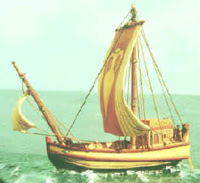 The Unit so far has consisted of learning the difference between design and engineering. At this point, you have learned that engineers have reasons, or a rationale for why they design and construct.
The Unit so far has consisted of learning the difference between design and engineering. At this point, you have learned that engineers have reasons, or a rationale for why they design and construct.If you were offered $100,000.00 to design a boat, it is likely the person paying what want to know upfront why you are designing it the way that you are.
It needs to have a function or purpose--not just looking cool.
The major design concepts thus far have been:
- Surface Area
- Resistance
- Force
- Balance
- Speed
- Stability
- Center of gravity
- leverage
Teams of students design their own ship's hull on paper, and build it using foam
and other everyday materials. Teams review all hull designs, predict which will go
farthest, and then test their design on water using a spring scale.
You are now ready to create the sail and describe your design choices. It is recommended that you take a look at traditional sails.
In your notebook, you should describe and estimate the size of the sail, the mast, and spar and the materials along with your reasons for the shape, how it works, and why.
At this point, you should have your preliminary hull designed and ready for testing, a sail in the design process or constructed, and you should be ready to race.
The four challenges are:
- Speed
- Stability
- Weight bearing
- General purpose
No comments:
Post a Comment